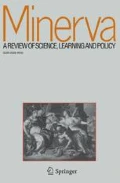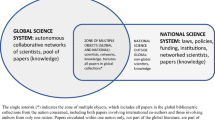Abstract
China’s remarkable gains in science over the past 25 years have been well documented but it is less well known that China and the United States have become each other’s top collaborating country. Science and technology has been a primary vehicle for growing the bilateral relationship between China and the United States since the opening of relations between the two countries in the late 1970s. During the early 2000s, the scientific relationship between China and the United States—as measured in coauthored papers—showed significant growth (Jin et al. in Journal of Shanxi University 30(2):295–302, 2007). Chinese scientists claim first authorship much more frequently than U.S. counterparts by the end of the decade. The sustained rate of increase of collaboration with one other country is unprecedented on the U.S. side. Even growth in relations with eastern European nations does not match the growth in the relationship between China and the United States. Both countries can benefit from the relationship, but for the U.S., greater benefit would come from a more targeted strategy.






Similar content being viewed by others
Notes
A U.S. Department of State report, “U.S.–China S&T Cooperation,” issued in July 2012, reports by agency on cooperative activities with China.
The U.S. Department of State report notes that NSF awarded more than $34.6 million to U.S. researchers engaged in collaboration with China; these funds were competitively awarded, not set aside to fund research with China.
The United States government tracks indicators of international activities in science and engineering, and publishes these data in a biennial report issued by the National Science Board through the auspices of the National Science Foundation. The Science & Engineering Indicators report uses a subset of the Science Citation Index and the Social Sciences Citation Index (Web of Science) data, thus, their results are not directly consonant with the results herein, which draw from a broader dataset. The Science & Engineering Indicators 2014 report indicated that the United States share of Chinese international articles was close to 48% in 2012. China’s share of U.S. international articles is reported to be 16.2% in 2012, where the calculation made by the authors using WoS data showed a lower percentage share. See NSB 2014, Table 5–23. The choice of database from which the data are drawn influences the results in that the Web of Science lists fewer journals overall than Scopus, for example. The reports noted by Archambault (2010) and the Royal Society (2011) used Scopus data. INSPEC is another database that reports on engineering and physical sciences; this database was used by Kostoff (2008).
A preliminary query using Scopus online revealed similar outcomes of the bilateral relationships of China and the United States during the years 2010–2013.
Since 2009, version 5 of WoS allows to identify the correspondence of the order of the authors and institutional affiliations. Before that date, however, the relation between the first authors and first institutional addresses—insofar as provided—was already unambiguous (Costas & Iribarren-Maestro 2007).
Russia’s ranking in the SCImago Journal and Country Rank also dropped through the decade from 9th in the world in 2000 to 16th in the world in 2012. www.scimagojr.com.
GERD is gross expenditure on research and development.
References
Acs, Zoltan J., David B. Audretsch, and Maryann P. Feldman. 2006. R&D spillovers and innovative activity. Managerial and Decision Economics 15(2): 131–138.
Adams, Jonathan. 2010. Get ready for China’s domination of science. New Scientist, 6 Jan., P. 2742.
Archambault, Eric. 2010. Thirty Years in Science: Secular Movements in Knowledge Creation. Report, Science-Metrix.com.
Arunachalam, Sidharth, R. Srinivasan, and V. Raman. 1994. International collaboration in science: Participation by the Asian giants. Scientometrics 30(1): 7–22.
Bonaccorsi, Andrea, and Juan Vargas. 2010. Proliferation dynamics in new sciences. Research Policy 39(8): 1034–1050.
Bornmann, Lutz, and Loet Leydesdorff. 2011. Which cities produce worldwide excellent papers more than can be expected? A new mapping approach-Using Google Maps-based on statistical significance testing. Journal of the American Society for Information Science and Technology 62(10): 1954–1962.
Bornmann, Lutz, Caroline Wagner, and Loet Leydesdorff. 2015. BRICS countries and scientific excellence: A bibliometric analysis of most frequently-cited papers. Journal of the Association for Information Science and Technology (JASIST). doi:10.1002/asi.23333.
Branstetter, Lee, Guangwei Li, and Francisco Veloso. 2013. The Globalization of R&D: China, India, and the Rise of international Co-invention. Informal paper. Carnegiemellon.edu.
Braun, T. 2005. Keeping the gates of science journals: Gatekeeping indicators of national performance in the sciences. In Handbook of quantitative science and technology research: The use of publication and patent statistics in studies of S & T systems, eds. H.F. Moed, W. Glänzel and U. Schmoch, 95–114. Dordrecht: Springer.
Braun, T., and I. Dióspatonyi. 2005. The counting of core journal gatekeepers as science indicators really counts. The scientific scope of action and strength of nations. Scientometrics 62(3): 297–319.
Cargill, Margaret, and Patrick O’Connor. 2006. Developing Chinese scientists’ skills for publishing in English: Evaluating collaborating-colleague workshops based on genre analysis. Journal of English for Academic Purposes 5(3): 207–221.
Cao, Cong, Richard P. Suttmeier, and Denis F. Simon. 2006. China’s 15-year Science and Technology Plan. Physics Today 59(12): 38.
Cassiolato, Jose Eduardo, and Helena M. Lastres. 2011. Science, technology and innovation policies in the BRICS countries: An introduction. In BRICS and development alternatives: Innovation systems and policies, eds. José Eduardo Cassiolato and Virginia Vitorino, 1–34. London: Anthem Press.
Costas, Rodrigo, and Isabel Iribarren-Maestro. 2007. Variations in content and format of ISI databases in their different versions: The case of the Science Citation Index in CD-ROM and the Web of Science. Scientometrics 72(2): 167–183.
Chen, David. 2011. China’s Program for Science and Technology Modernization: Implications for American competitiveness. Centra technologies report for the U.S.–China Economic and Security Review Commission.
Duque, Ricardo B., Marcus Ynalvez, Paul Mbatia, R. Sooryamoorthy, Dan-Bright Dzorgbo, and Wesley Shrum. 2005. Collaboration paradox: Scientific productivity, the Internet, and problems of research in developing areas. Social Studies of Science 35(5): 755–785.
Freeman, Richard B. 2006. Does globalization of the scientific/engineering workforce threaten US economic leadership? In Innovation policy and the economy, vol. 6, eds. Adam B. Jaffe, Josh Lerner, and Scott Stern, 123–158. Cambridge, MA: The MIT Press.
Fu, Hui-Zhen, and Yuh-Shan Ho. 2013. Independent research of China in Science Citation Index Expanded during 1980–2011. Journal of Informetrics 7(1): 210–222.
Gao, Jian, and Gary H. Jefferson. 2007. Science and technology take-off in China? Sources of rising R&D intensity. Asia Pacific Business Review 13(3): 357–371.
Glänzel, Wolfgang, Andreas Schubert, and H.J. Czerwon. 1999. A bibliometric analysis of international scientific cooperation of the European Union (1985–1995). Scientometrics 45(2): 185–202.
Glänzel, Wolfgang, and Andreas Schubert. 2001. Double effort = double impact? A critical view at international co-authorship in chemistry. Scientometrics 50(2): 199–214.
He, Tianwei. 2009. International scientific collaboration of China with the G7 countries. Scientometrics 80(3): 571–582.
Institute of International Education. 2014. Open doors report, 2013. http://www.iie.org/research-and-publications/open-doors. Accessed 13 April 2014.
Jin, Bihui, and Ronald Rousseau. 2005a. Evaluation of research performance and scientometric indicators in China. In Handbook of quantitative science and technology research, eds. Henk F. Moed, Wolfgang Glänzel, and Ulrich Schmoch, 497–514. Dordrecht: Springer.
Jin, Bihui, and Ronald Rousseau. 2005b. China’s quantitative expansion phase: Exponential growth but low impact. In Proceedings of ISSI 2005 (Ingwersen & Larsen, eds.), 362–370.
Jin, Bihui, Richard P. Suttmeier, Z. Wang, Cong Cao, D. Wang, and Q. Zhou. 2007. Sino–U.S. science collaboration: An analysis in bibliometrics. Journal of Shanxi University (Natural Science Edition) 30(2): 295–302.
Jin, Xioming. 2003. China–US Relations in Science, Conference Paper. http://darkwing.uoregon.edu/~chinaus/publications/. Accessed April 2014.
Katz, J. Sylvan, and Ben R. Martin. 1997. What is research collaboration? Research Policy 26(1): 1–18.
Klavans, Richard, and Kevin W. Boyack. 2009. Toward a consensus map of science. Journal of the American Society for Information Science and Technology 60(3): 455–476.
Kostoff, R.N. 2008. Comparison of China/USA science and technology performance. Journal of Informetrics 2(4): 354–363.
Leydesdorff, Loet, and Caroline S. Wagner. 2008. International collaboration in science and the formation of a core group. Journal of Informetrics 2(4): 317–325.
Leydesdorff, Loet, Caroline S. Wagner, and Lutz Bornmann. 2014. The European Union, China, and the United States in the Top-1% and Top-10% Layers of Most-Frequently-Cited Publications: Competition and collaborations. Journal of Informetrics 8(3): 606–617.
Lin, Songqing. 2013. Why serious academic fraud occurs in China. Learned Publishing 26(1): 24–27.
Narin, Francis, K. Stevens, and Edith S. Whitlow. 1991. Scientific co-operation in Europe and the citation of multinationally authored papers. Scientometrics 21(3): 313–323.
National Science Board. 2000. Science and engineering indicators. Washington, DC: National Science Foundation.
National Science Board. 2010. Science and engineering indicators. Washington, DC: National Science Foundation.
National Science Board. 2012. Science and engineering indicators. Washington, DC: National Science Foundation.
National Science Board. 2014. Science and engineering indicators. Washington, DC: National Science Foundation.
OECD. 2008, Main science and technology indicators, vol. 2008/1. Paris: OECD.
Pentland, W. 2011. Congress Bans Scientific Collaboration with China, Cites High Espionage Risks. Forbes, May 7, 2011. Accessed April 2014.
Rafols, Ismael, Alan Porter, and Loet Leydesdorff. 2010. Science overlay maps: A new tool for research policy and library management. Journal of the American Society for Information Science and Technology 61(9): 1871–1887.
Royal Society. 2011. Knowledge, networks, and nations: Global scientific collaboration in the 21st century. London: Royal Society.
Shelton, R.D., and Loet Leydesdorff. 2012. Publish or patent: Bibliometric evidence for empirical trade-offs in national funding strategies. Journal of the American Society for Information Science and Technology 63(3): 498–511.
Shelton, Robert Duane, and Patricia Foland. 2009. The race for world leadership of science and technology: status and forecasts. In Proceedings of the 12th International Conference of the International Society for Scientometrics and Informetrics, pp. 369–380.
Springut, Micah, Stephen Schlaikjer, and David Chen. 2011. China’s Program for Science and Technology Modernization: Implications for American Competitiveness: Prepared for the US–China Economic and Security Review Commission. CENTRA Technology.
Sun, Fuquan. 2012. International Science and Technology Cooperation of China: Evolution, Progress and Achievements, Problems and Prospects. Chinese Academy of Science and Technology for Development, internal paper.
Suttmeier, Richard P. 2008. State, self-organization, and identity in the building of Sino–US cooperation in science and technology. Asian Perspective 32(1): 5–31.
Suttmeier, Richard P. 2010. From Cold War science diplomacy to partnering in a networked world: 30 years of Sino–US relations in science and technology. Journal of Science and Technology Policy in China 1(1): 18–28.
Tang, Li, and Philip Shapira. 2011. China–US scientific collaboration in nanotechnology: patterns and dynamics. Scientometrics 88(1): 1–16.
United Nations Educational, Scientific and Cultural Organization. 2010. UNESCO science report 2010. Paris: UNESCO.
Van Leeuwen, T.N., Henk Moed, Robert Tijssen, M.S. Visser, and Ton van Raan. 2000. First evidence of serious language-bias in the use of citation analysis for the evaluation of national science systems. Research Evaluation 9(2): 155–156.
Wagner, Caroline S., Irene Brahmakulam, D.J. Peterson, Linda Staheli, and Anny Wong. 2002. U.S. Government funding of science and technology cooperation with Russia. Santa Monica: RAND Corporation. http://www.rand.org/pubs/monograph_reports/MR1504.html.
Wagner, Caroline, and Loet Leydesdorff. (in preparation). Implications for U.S. science policy of the growth of global science.
Wagner, Caroline S., and Shing Kit Wong. 2012. Unseen science? Representation of BRICs in global science. Scientometrics 90(3): 1001–1013.
Wilsdon, James, and J. Keeley. 2007. China: The next science superpower. London: Demos.
Zhou, Ping. 2013. The growth momentum of China in producing international scientific publications seems to have slowed down. Information Processing and Management 49: 1049–1051.
Zhou, Ping, and Loet Leydesdorff. 2006. The emergence of China as a leading nation in science. Research Policy 35(1): 83–104.
Zhou, Ping, Bart Thijs, and Wolfgang Glänzel. 2009. Is China also becoming a giant in social sciences? Scientometrics 79(3): 593–621.
Author information
Authors and Affiliations
Corresponding author
Rights and permissions
About this article
Cite this article
Wagner, C.S., Bornmann, L. & Leydesdorff, L. Recent Developments in China–U.S. Cooperation in Science. Minerva 53, 199–214 (2015). https://doi.org/10.1007/s11024-015-9273-6
Published:
Issue Date:
DOI: https://doi.org/10.1007/s11024-015-9273-6




